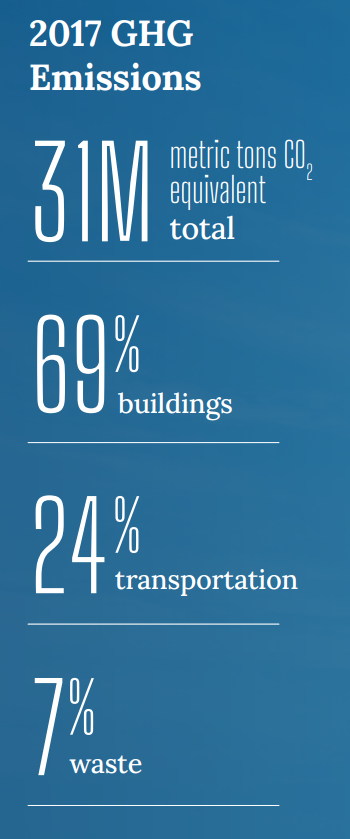Electrify Chicago
An independent tool for viewing City of Chicago building data
According to the
2022 Chicago Climate Action Plan,
69% of Chicago's emissions come from buildings, making
building emissions our biggest challenge and our biggest opportunity as a city
to tackle climate change. At Electrify Chicago, we showcase building performance using
publicly available data supplemented by community-submitted photographs and building
owners.
Start by looking at Chicago's buildings with the highest greenhouse gas intensity i.e. emissions per square foot. Large, efficient, buildings can perform much better than very inefficient small buildings on this metric.
New Article
📰 $30 Million In Missed Fines
The City Of Chicago failed to collect $30 million in potential fines from the building benchmarking ordinance, reducing transparency and accountability.
Legislative update! 🎉
As of late January 2024, legislation is being introduced to require new use more efficient forms of water and space heating, via the Clean And Affordable Buildings Ordinance (CABO), which will reduce the number of highly polluting and inefficient buildings that end up on this site.
If you're in Chicago,
write to your alderman to support the CABO!
Chicago Buildings by Greenhouse Gas Intensity
Note: Data includes large Chicago buildings with data from 2022, unless explicitly stated otherwise.
Note: This data only includes buildings whose emissions are reported
under the
Chicago Energy Benchmarking Ordinance. According to the City “As of 2016,
this list includes all commercial, institutional, and residential buildings larger than
50,000 square feet.” This dataset is also then filtered to only buildings with
reported emissions > 1,000 metric tons CO2 equivalent.
The latest year of data is from 2022, but we update the site regularly when new data is available, and some buildings may have failed to report that year, and only have older data available.
| Property Name / address | Primary Property Type |
Greenhouse Gas Intensity (kg CO2 eq./sqft) |
Total Greenhouse Emissions (metric tons CO2 eq.) |
|---|---|---|---|
|
630 644 W ADDISON ST
630 644 W ADDISON ST
| Multifamily Housing | 6.2 kg/sqft
Lowest 46%
| 314 tons
Lowest 9%
|
|
Webster Square Apartments
🕰️
558 W WEBSTER AVE
| Multifamily Housing | 6.2 kg/sqft | 484 tons |
|
4848 N KEDZIE AVE
4848 N KEDZIE AVE
| Multifamily Housing | 6.2 kg/sqft
Lowest 46%
| 340 tons
Lowest 11%
|
|
410 E BOWEN AVE
🕰️
410 E BOWEN AVE
| Multifamily Housing | 6.2 kg/sqft | 754 tons |
|
4101 4115 S MICHIGAN AVE
4101 4115 S MICHIGAN AVE
| Multifamily Housing | 6.2 kg/sqft
Lowest 46%
| 311 tons
Lowest 9%
|
|
Waveland Gardens
🕰️
626-630 West Waveland
| Multifamily Housing | 6.2 kg/sqft | 345 tons |
|
1040 W HOLLYWOOD AVE
1040 W HOLLYWOOD AVE
| Multifamily Housing | 6.2 kg/sqft
Lowest 46%
| 378 tons
Lowest 15%
|
|
180 N LaSalle St
180 N LaSalle St
| Office | 6.2 kg/sqft
Lowest 46%
| 5,356 tons
Highest 6%
|
|
Daley Center
(DePaul)
14 E Jackson Blvd
| College/University | 6.2 kg/sqft
Lowest 46%
| 2,293 tons
Highest 19%
|
|
018110 - Union Tower, LLC
550 W Van Buren
| Office | 6.2 kg/sqft
Lowest 46%
| 2,070 tons
Highest 22%
|
|
333 N Michigan
333 N Michigan Ave
| Office | 6.2 kg/sqft
Lowest 46%
| 2,240 tons
Highest 20%
|
|
Fine Arts Building
408 410 S Michigan Ave
| Office | 6.2 kg/sqft
Lowest 46%
| 993 tons
Highest 45%
|
|
2071 N Southport Avenue
2071 N Southport Avenue
| Office | 6.1 kg/sqft
Lowest 45%
| 501 tons
Lowest 26%
|
|
Marquee at Block 37
25 West Randolph Street
| Multifamily Housing | 6.1 kg/sqft
Lowest 45%
| 3,583 tons
Highest 10%
|
|
NEMA Chicago
1200 S Indiana Ave
| Multifamily Housing | 6.1 kg/sqft
Lowest 45%
| 6,791 tons
Highest 4%
|
Data Source:
Chicago Energy Benchmarking Data
